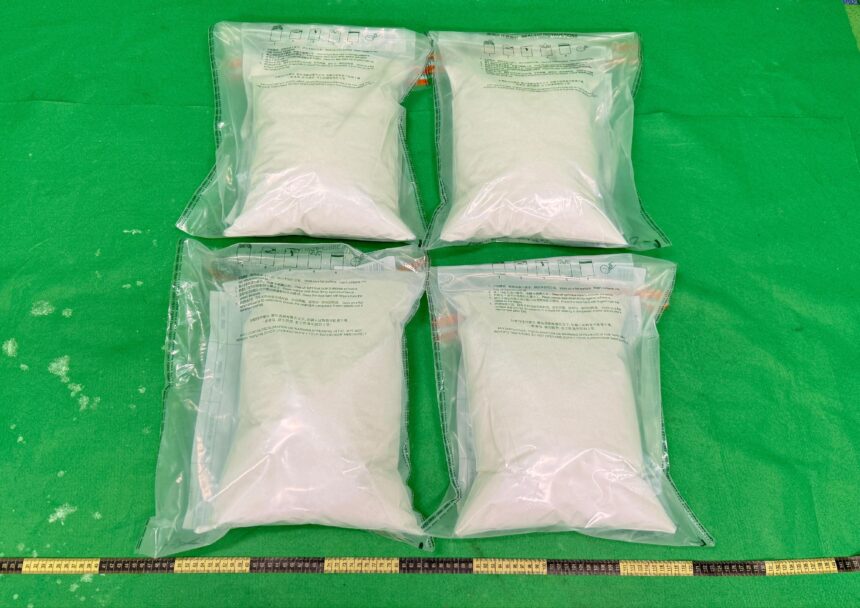Authorities at McCarran International Airport in Las Vegas have apprehended a traveler found in possession of 72 pounds of ketamine, according to federal officials. The significant seizure highlights ongoing efforts to intercept illegal drug trafficking through major transportation hubs. The investigation remains active as authorities work to determine the source and intended distribution network connected to the narcotics.
Traveler Apprehended at Las Vegas Airport with Large Ketamine Shipment
Federal authorities intercepted a traveler at McCarran International Airport in Las Vegas carrying an unusually large quantity of ketamine, weighing approximately 72 pounds. The substance was concealed within multiple checked luggage items, sparking immediate suspicion during routine security checks. Officials confirmed the shipment was bound for distribution, highlighting a significant bust in the ongoing battle against drug trafficking through major U.S. transportation hubs.
- Location: McCarran International Airport, Las Vegas
- Quantity: 72 pounds of ketamine
- Seizure Agents: Federal Drug Enforcement Administration (DEA)
- Suspect Status: Detained pending further investigation
| Item | Weight (lbs.) | Description |
|---|---|---|
| Ketamine Packaging | 72 | Multiple sealed packets in luggage |
| Suspect’s Travel Route | Unknown origin to Las Vegas with possible onward domestic flights | |
Federal Authorities Detail Investigation and Seizure Process
Federal authorities meticulously followed a multi-step process upon intercepting the suspect at the Las Vegas airport. Agents from the Drug Enforcement Administration (DEA), in collaboration with Customs and Border Protection (CBP), conducted a thorough search following initial suspicions raised by behavioral analysis and X-ray screening technology. After the discovery of the 72 pounds of ketamine, the individual was detained, and the narcotics were immediately secured for further examination.
The seizure process involved detailed documentation, including chain of custody logs to ensure evidence integrity. Below is an outline of the key steps undertaken by federal agents:
- Initial Detection: Use of advanced scanning and profiling techniques to flag the suspect.
- Physical Inspection: Manual search and verification of concealed compartments in luggage.
- Detainment: Immediate custody transfer of the traveler pending further interrogation.
- Evidence Processing: Securing and transporting the ketamine samples to DEA laboratories for quality and purity analysis.
- Case Documentation: Creation of detailed reports and preparation for federal prosecution.
| Step | Action | Responsible Agency |
|---|---|---|
| 1 | Initial X-ray Screening | CBP |
| 2 | Behavioral Assessment | DEA & CBP |
| 3 | Arrest and Detainment | DEA |
| 4 | Seizure Documentation | DEA |
| 5 | Laboratory Analysis | DEA Forensics |
Legal Implications and Potential Charges for Drug Trafficking
Individuals apprehended with substantial quantities of ketamine, such as the reported 72 pounds, face grave legal consequences under federal and state statutes. The sheer volume of the substance often triggers charges of drug trafficking, which carry significantly more severe penalties compared to simple possession. Convictions can result in lengthy prison terms, hefty fines, and permanent criminal records. Additionally, law enforcement agencies may pursue asset forfeitures connected to trafficking activities, further complicating the defendant’s legal standing.
Legal charges typically associated with drug trafficking include:
- Possession with intent to distribute
- Conspiracy to traffic controlled substances
- Importation or exportation of illegal drugs
- Money laundering related to drug proceeds
| Charge | Potential Penalty |
|---|---|
| Possession with Intent to Distribute | 5-20 years imprisonment |
| Drug Trafficking | 10 years to life imprisonment |
| Conspiracy Charges | Up to 10 years imprisonment |
| Asset Forfeiture | Seizure of property related to crime |
Security Measures and Recommendations for Airport Drug Prevention
To effectively combat the smuggling of illicit substances like ketamine through airports, a multi-layered approach to security is essential. Authorities recommend employing advanced scanning technologies such as 3D computed tomography and body scanners that can detect concealed drugs without invasive searches. Enhanced training programs for security personnel are crucial, focusing on the latest concealment techniques and behavioral detection methodologies. Additionally, inter-agency cooperation facilitates real-time intelligence sharing, allowing for expedited identification of high-risk travelers and cargo shipments.
Complementing technology and training, airports should implement robust passenger profiling and random screening protocols without compromising privacy rights. Public awareness campaigns can also play a role in deterrence by educating travelers on legal consequences and the dangers of drug trafficking. Below is a brief outline of recommended measures:
- Deployment of cutting-edge scanning equipment at all security checkpoints
- Regular cross-agency intelligence briefings to identify trafficking trends
- Comprehensive training programs emphasizing detection and procedural consistency
- Randomized and intelligence-based passenger screenings to increase unpredictability
- Public outreach initiatives to promote awareness and compliance
| Security Measure | Benefit |
|---|---|
| 3D CT Scanning | Detailed inspection of luggage content |
| Behavioral Analysis Training | Identifies suspicious actions early |
| Inter-agency Data Sharing | Accelerates threat detection |
| Randomized Screening | Deters traffickers by unpredictability |
Insights and Conclusions
The incident serves as a stark reminder of the ongoing challenges faced by law enforcement in curbing the illegal drug trade at major transportation hubs. Authorities continue to investigate the case, while emphasizing the importance of vigilance and cooperation from the public to prevent similar attempts in the future. Further updates will be provided as the investigation develops.
